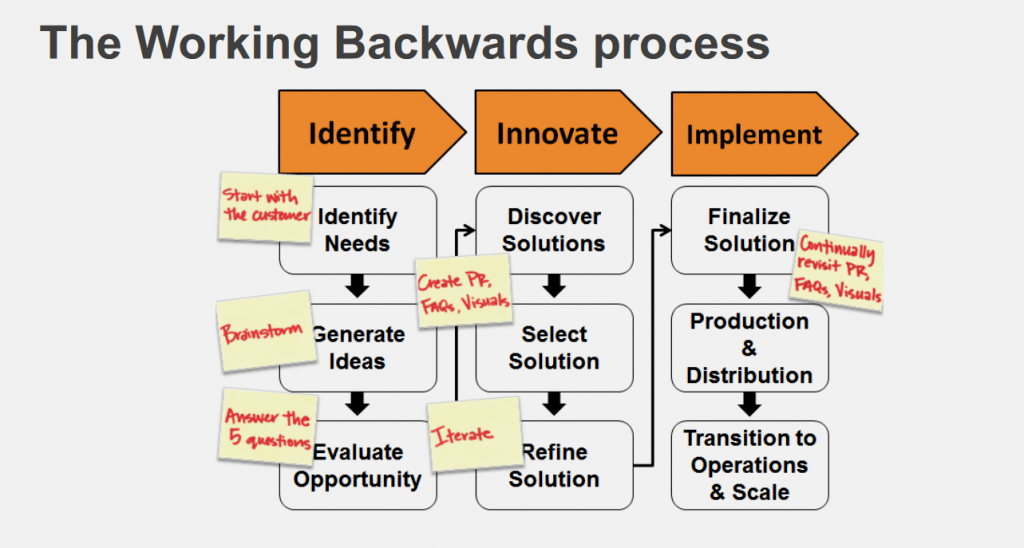Creating a product vision is not just the first step towards embarking on the journey of successful product development, it is the most critical one.
“Be stubborn on vision, but flexible on details” – Jeff Bezos
Enterprises across the globe have various tools and methodologies for arriving at the product vision. PR FAQs (Press Release FAQs) is one such tool. A PR FAQs document is a press release including critical FAQs, that is written for a product that will be released in the future. It is usually written by the product teams for a hypothetical launch of a product, considering that it is already released.
The concept of PR FAQs first introduced by Amazon is now used by product teams across organizations.
What is a PR FAQs and how it helps in creating customer-centric products
At Robosoft, we use Design Thinking principles to understand users’ pain points and needs and then create a product vision that not just solves the real challenges of customers but is in line with our clients’ business goals as well. PR FAQs is a tool that can help product teams present these learnings in a simple format for all the stakeholders across the organization.
Creating PR FAQs is an approach where the product teams work backwards – i.e. they visualize how their end product will look, what consumer challenges it will solve, and how it will solve it? All these are then addressed in the PR FAQs document while keeping customer needs at the center.
The concept of Amazon Go, the chain of automated convenience stores, was a direct result of the “working backwards” approach, which begins with the creation of a PR FAQs document (a press release, frequently-asked questions document, and visual mock-ups). In this case, it all began with identifying the problem: customers hate standing in lines, using the PR FAQs tool.

Image source
Typically, product managers use a product brief to describe their product. This serves as a starting point for the company’s product development and a brief introduction. A PR FAQs document serves as a more futuristic and customer-oriented product brief.
Product teams create a PR FAQs document imagining that the product is already developed and released. They have already envisioned the final product in their minds while writing a PR FAQs document.
Usually, a PR FAQs document will answer the following questions for all stakeholders – design, development, sales & marketing teams, etc.
- What does the product do?
- What are the most exciting features?
- What customer problems are you solving?
- What benefits will the users get?
The format for a typical product brief is as follows:
- A press release: Written from the point of when the product will be released and how it would be introduced to the public.
- FAQ: Potential questions that a given customer would likely ask in order to gain knowledge of the product. The questions are usually framed to seem open-ended.
- Internal questions: Questions that are asked by the stakeholders during the product development phase.
Now let us take a look at a PR FAQs template:
- Heading: Short, catchy name for the product that a given target audience can relate to.
- Subheading: One-liner explaining who the target market is, what the product does, and what it hopes to achieve.
- Summary: A brief paragraph, explaining what the product is and its benefits.
- Problem Statement: A brief paragraph explaining what precise problem the company is trying to solve with this product and why they are trying to solve this problem. This paragraph may also include pain points on existing products or processes that can be alleviated using the product.
- Solution: A brief explanation of how the company hopes to resolve the problem mentioned in the prior paragraph. Usually, it would be helpful to provide research or numbers to back the assumptions made for the resolution.
- User Experience: A paragraph explaining how a user would interact with the product itself. In this section one could add an internal quote; something regarding the product for example, why the company feels it’s essential for the given customer base to purchase this product. One could also add hypothetical customer quotes. This kind of information gives more insight into the product or the features.
- FAQs: This section would include all plausible questions target customers may want to ask. This includes the typical what, why, when, how, and who questions from the customer’s perspective. This could also serve as a justification for the company to launch the given product.
- Internal Section: This part of the document involves questions that the internal teams would ask. These questions could be regarding technical, sales, marketing, or design inquiries. The section would also delve into the solutions for any said questions and would make it transparent for teams to see where this product/feature is heading and what the ask is especially from the stakeholders. It could act as an aid to stakeholders for decision-making purposes. Typically, visuals could be added to avoid having to write out large chunks of words and would help keep it brief.
Some samples of how a hypothetical press release looks like can be found here and here.
Why it is important for product teams to create a PR FAQs document before starting the product design and development journey
A PR FAQs is a commitment to deliver
The PR FAQs is much more than a product brief tool. The press release opens with a location and date of publication; this helps the product team to focus on an idea and commit to meeting their tentative delivery date. Along the way, details and dates might change, but it keeps teams accountable to ultimately deliver on their vision. A PR FAQs is more than a document – it’s a commitment to deliver
Gives perspective to all the product stakeholders
A PR FAQs is written keeping customers at the center and is aimed to give all the stakeholders a brief about the product idea. But, if the PR FAQs document is not clear or exciting enough, the product idea might need to be refined further. A PR FAQs document can help identify shortfalls in the product idea at a very initial stage and can help identify issues like – cramming too many features, or not being able to address the real user pain-points and more. If stakeholders are asking questions that can’t be answered in the FAQs, then the product idea needs to be refined further before starting to build it.
As McAllister, former General Manager at Amazon explains, “Iterating on a press release is a lot less expensive than iterating on the product itself (and quicker!).”
Furthermore, the FAQ component of the document can be extremely effective in capturing the assumptions and perspectives of different stakeholders in a consistent format that everyone involved can understand.
Helps in defining product vision and roadmap
A PR FAQs document can give focus and clarity on the challenges the product will solve for customers. It helps articulate what the client experience needs to be, defines specific requirements that are needed for the final product, highlights the most important features, and hence helps create a product vision and a roadmap.
Motivates the design and development teams to create an exciting product
A PR FAQs document can help product teams test their product idea and gain buy-ins from clients and internal teams on particular features or the product overall. A press release should be engaging and exciting and explaining what your product does. If the press release is not exciting, chances are the product isn’t going to be engaging either.
Getting the stakeholders excited about a “press release” sets the stage for motivated teams when the actual product is built.
How a PR FAQs document can help various stakeholders in the product development journey
A PR FAQ document is useful not just for the product teams but multiple stakeholders in the product design and development journey. Here’s how:
Engineering teams: PR FAQs document can be used to start scoping out the technical aspects of the product. The development team can start by looking at what the product is, how it will help solve any issues, and how much time it will take.
While a product document might be independent of the technical solution, it can help to include some details that will give reviewers an idea of the scale of potential solutions.
The PR FAQs document can be beneficial for the engineering team to immediately start thinking about solutions to the product: what are the code libraries, databases, caching solutions, etc.?
Design teams: the PR FAQs document can help design teams to start thinking about design concepts. It is not necessary to create a text-focused PR FAQs document. Adding a basic wireframe or an MVP concept can help the design teams to further visualize the design elements.
Sales teams: the PR FAQs document can help sales teams to start looking into the marketing of the product, what the market would be, who would buy it, and how profitable it would be for the company.
Marketing teams: the PR FAQs document can help marketing teams craft a key message or benefit that would be attractive to the end customer.
Other Stakeholders: the PR FAQs document can be used to see what resources need to be assigned to this product and how much time it would take to accomplish its implementation.
In Conclusion:
In situations where the product brief or PR FAQs document is cumbersome and difficult, it can be an indication that the product itself might not be worth the effort for implementation. Although, this might not hold true for all products and vary according to the product idea. Each company must find its own way of approaching the implementation of the product and see what works for them.
The most appropriate way to approach the process would be to begin with the basic given format described above and customize the product along the way. This allows for flexibility in the flow of the writing as well as allows room for things such as visuals and graphs that can be beneficial to decision-makers and stakeholders.
Download the above template for creating a PR FAQs document for the next product idea of your enterprise.
